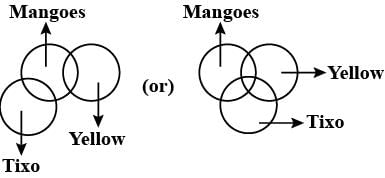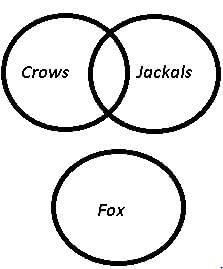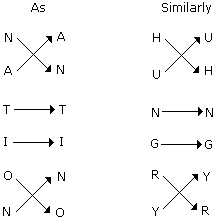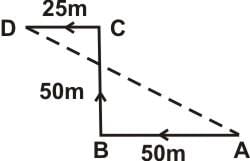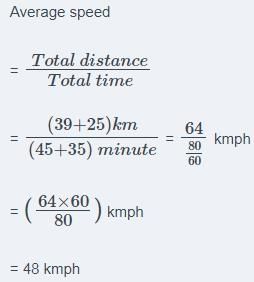DSSSB TGT Social Science Mock Test - 3 - DSSSB TGT/PGT/PRT MCQ
30 Questions MCQ Test DSSSB TGT Mock Test Series 2025 - DSSSB TGT Social Science Mock Test - 3
By which reaction metal is obtained from metal oxide ?
A, P, R, X, S and Z are sitting in a row. S and Z are in the centre. A and P are at the ends. R is sitting to the left of A. Who is to the right of P ?
Look at this series: 53, 53, 40, 40, 27, 27,...so on. What number should come next?
Statements:
Some mangoes are yellow.
Some tixo are mangoes.
Conclusions:
(1) Some mangoes are green.
(2) Tixo is a yellow.
In a certain code LAWN is written as JCUP. How will SLIT be coded in that code?
In this following question, four words have been given, out of which three are alike in some manner and the fourth one is different. Choose out the odd one out.
Directions : In each question below are given two Statements: followed by two conclusion numbered I and II. You have to take the two given statement to be true even if they seem to be at variance with commonly known facts and then decide which of the given Conclusions: logically follows from the two given statement, disregarding commonly know facts.
Statements:
Some crows are jackals.
No fox is crow.
Conclusions:
I. Some jackals are foxes.
II. Some jackals are not foxes.
Directions to Solve
In each of the following questions find out the alternative which will replace the question mark.
Question -
NATION : ANTINO :: HUNGRY : ?
Directions to Solve
In each of the following questions find out the alternative which will replace the question mark.
Question -
K/T : 11/20 :: J/R : ?
The diagram given below represents those students who play Cricket, Football and Kabaddi.

Study the diagram and identify the students who play all the three games.
The door of Adithya's house faces the East. From the back side of his house, he walks straight 50 metres, then turns to the right and walks 50 metres again. Finally, he turns towards left and stops after walking 25 metres. Now, Aditya is in which direction from the starting point?
In a certain code, MONKEY is written as XDJMNL. How is TIGER written in that code?
Suresh for 2 years invested Rs. 500 in SBI. He also invested Rs. 300 in ICICI for 4 years. At the end he received Rs. 220 from both banks as simple interest. What must have been rate of interest? (assuming the rate of interest for both banks is same)
In a mixture of 100 litres of milk and water, 25% of the mixture is milk. How much water should be added to the mixture so that milk becomes 20% of the mixture?
What will be the compound interest on a sum of Rs. 40,000 after 3 years at the rate of 11 p.c.p.a.?
Salaries of Ravi and Sumit are in the ratio 2 : 3. If the 'salary of each' one of them is increased by Rs. 4000, the new ratio becomes 40 : 57. What is Sumit's present salary?
A car covers first 39 km of its journey in 45 minutes and the remaining 25 km in 35 minutes. What is the average speed of the car?
The following line graph gives the percent profit earned by two Companies X and Y during the period 1996 - 2001.

Percentage profit earned by Two Companies X and Y over the Given Years
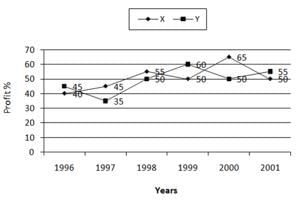
Q.
The incomes of two Companies X and Y in 2000 were in the ratio of 3:4 respectively. What was the respective ratio of their expenditures in 2000?
A man is paid Rs. 20 for each day he works and loses Rs. 3 for each day he is idle. At the end of 60 days he gets Rs. 280. Then he was idle for
A man sold 18 cots for Rs. 16800, gaining there by the cost price of 3 cots. Find the cost price of a cot.
The sum of seven consecutive numbers is 175. What is the sum of the first and the last number
(Q.no: 16 -20). Refer to the table and answer the given questions.
In 2011, the respective ratio of total number of votes to valid votes was 5:4. Number of valid votes of female in 2011 constitutes what percent of the total number of votes in the same year?
A reputed company sells a wrist watch to a wholesaler making a profit of 10%. The wholesaler, in turn, sells it to the retailer making a profit of 10%. A customer purchases it by paying Rs. 990. Thus the profit of retailer is 2(3/11)% What is the cost incurred by the the company to produce it?
A car travels from a place A to B in 7 hour. It covers half the distance at 30 kmph and the remaining distance at 40 kmph, what is the total distance between A and B?
Among four persons Anuj, Bhim, Carl and Dinesh. Anuj takes thrice as much time as Bhim to complete a piece of work. Bhim takes thrice as much time as Carl and Carl takes thrice as much time as Dinesh to complete the same work. If all together they take 3 days to complete the work. Find the time taken by Bhim alone to complete the work alone.
The H.C.F. of two numbers is 11 and their L.C.M. is 7700. If one of the numbers is 275, then the other is:
The cost of packaging of the oranges is 20% the cost of fresh oranges themselves. The cost of oranges increased by 30% but the cost of packaging decreased by 50%, then the percentage change of the cost of packed oranges, if the cost of packed oranges is equal to the sum of the cost of fresh oranges and cost of packaging




